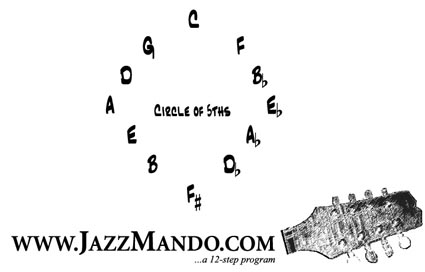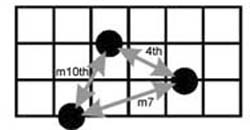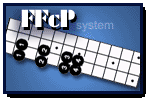« January 2011 |
Main
| March 2011 »
 February 24, 2011 | 3-note Chord Dominants; Part 2 (Circle of Fifths)
February 24, 2011 | 3-note Chord Dominants; Part 2 (Circle of Fifths)
Last week we introduced you to the concept of 3-note V7 chords and the subsequent inversions. If you haven't had the chance already to internalize these, we'd suggest going back for an intense review. The context was being able to move up the same chord, A7 for example, and voice it in it's three different incarnations up and down the fretboard. You would do well to practice shifting around these, if nothing else to get them to feel comfortable. Keep in mind EVERY 3-note V7 chord will be one of these four blocks, no matter what key you're in. It's simply a matter of moving up frets or over a string, and you have all 12 keys literally at your fingertips.

What we want to do now is go back to the way a V7 chord moves into another V7, otherwise known as the Circle of Fifths. We've mentioned this here before, and you may have heard the term bantered about in a jam session. The most familiar is any tune that uses "I Got Rhythm" as the basic chord layout, and in particular, the bridge of the song. It's very common, and you'll find a useful tool is being able to voice a progression of 5ths smoothly, such as they way we've blocked these in the diagrams below. Notice how even though the root of the chord is jumping an entire 5th (or 7 frets) A7, D7, G7, C7, you aren't moving more than two frets with these inversions. It's VERY fluid!
   
All we've done is utilize the inversion of the next chord that is closest. Don't worry about it as being 1st inversion, 2nd, etc. just know that it's the one that uses the least amount of jumping. You could even continue on through the Circle (F7, Bb7, Eb7, Ab7, etc) except you've run out of fretboard, and would have to continue an octave up.
Take a look at starting with the A7 in another inversion. Here's a way to voice it:
   
Again, very fluid, only a couple frets at the most. For you theory geeks, the 3rd and 7th "Tritone" is the center of it all, and each root movement up a Fifth slides the Tritone down one fret. Pretty cool pattern, eh?
Continuing on:
   
When we run our fourth and final variation, we run out of fingerboard on the G7 (at least if we want a closed position chord), so we have to move everything up an octave. Again, if you wanted to continue the succession of Fifths, F7, Bb7, Eb7, Ab7, Db7, etc. it's very obvious how this cycles on.
   
If you're playing "Sweet Georgia Brown" in the key of F major, you can use the 2nd, 3rd, and 4th of these blocks. Another is "Autumn Leaves." You'll be surprised at how many use a succession of three more V7 chords in this relationship, and with this under your belt, you're at the ready immediately!
Further:
3-note Chord Dominants; Part 1 (Inversions)
Fretboard Geometry
Circle of Fifths Examples
Secondary Dominants
What you can do with a V7 chord: Declaring Dominants
Posted by Ted at 6:23 AM
 February 17, 2011 | 3-note Chord Dominants; Part 1 (Inversions)
February 17, 2011 | 3-note Chord Dominants; Part 1 (Inversions)
So you're jamming along, playing your 193rd chorus of "Sweet Georgia Brown," and struggling to make your comping sound interesting, but four chronic measures of the same D7, D7, D7, D7, etc. is starting to get to you. What can you do to make this interesting not only for your audience, but yourself?
Easy answer: Inversions.
We brought up 3-note chords last week, and mentioned their incredible transposabilty on a fifths tuned instrument. Let's apply this in the context of moving the same chord up the fretboard, and take one of the two most common chords, the Dominant 7 (V7), and show you some tricks. In institutional Music Theory studies, you learn that the way you label inversion of a chord is based on the bass note. This may be esoteric information right now, as a mandolinist, you're not thinking the bass note in an ensemble because it's highly likely someone lower is covering that, but for today's purposes, we'll mention the labels of Root, 1st Inversion, 2nd Inversion, and 3rd Inversion, if nothing else than to give some distinction later. The main thing for you now is to learn four different ways to play an A7 chord on the mandolin fretboard. Get comfortable with them. Learn them until you forget them. Move from one to the next, and if you have a song with four measures of A7, at very minimum, pick a pair and move back and forth from one to the next.
   
Notice the freshness you can inject into your comping by varying the inversions. You're still communicating the same harmonic language, but you're expressing a different viewpoint. It's like walking around a statue in an art gallery--it's the same statue, but each angle is a different perspective. Three dimensional views give a more robust aesthetic experience, and the same can be said for the exchange of chord inversions.
Now, we are going to take this same approach with a D7 chord. These are all different inversions, and for you theory buffs, the name is based on the bass (lowest sounding) note of the chord. Root in the bottom, 1st Inversion (3rd in the bass), 2nd Inversion (5th in the bass), and 3rd Inversion (7th in the bass).
   
We're going to take this concept farther in this series of 3-note dominant chords. For now, get used to these as written. For extra credit, go ahead and try these patterns in other keys. Next week will look at how you can do the Circle of Fifths with these as the basis, and get you into a less static way to play the bridge from "I Got Rhythm," and other "Circle of Fifths" tunes.
While you're practicing the above chords, trying pairing an A7 with a D7 by playing the A7 chord, and the D7 from the row directly below. Observe how little you have to move the fingers--one or two of them. Classic economy of motion, and better yet, incredibly good voice leading.
We'll have some more fun with these!
Further:
Fretboard Geometry
Circle of Fifths Examples
Functional thinking...
Secondary Dominants
What you can do with a V7 chord: Declaring Dominants
Posted by Ted at 11:44 AM
 February 10, 2011 | Three's company. 3-note chord
February 10, 2011 | Three's company. 3-note chord
Outside of legendary jazz guitarist Les Paul, there's nothing that demonstrates the "Less is more" better than 3-note chords on the mandolin fretboard. Especially those coming from a guitar background, or even a folk music one, we study the instrument with the notion that we can only get rich, full sound by stroke chords that use all eight strings (four notes), and that becomes a trap. When we think we need four voices in a chord, that actually limits the variations. If you make a formation using the three lowest strings, you can move it up every available fret. You can then double your money by moving that whole block up a string to the three highest ones.
 There's also a sound "Three is enough" harmonic principle in the concept of ensemble playing in mandolin Chord Economics. In a nutshell, of the 7th chord, the bass is being played by a lower voiced instrument, the 5th (unless it's altered) is harmonically insignifcant, and even after voicing the critical 3rd and 7th, you still have an extra voice their to add a color tone 9th, 11th, or 13th, or even another voicing of the root. There's also a sound "Three is enough" harmonic principle in the concept of ensemble playing in mandolin Chord Economics. In a nutshell, of the 7th chord, the bass is being played by a lower voiced instrument, the 5th (unless it's altered) is harmonically insignifcant, and even after voicing the critical 3rd and 7th, you still have an extra voice their to add a color tone 9th, 11th, or 13th, or even another voicing of the root.
If you've considered tackling a 5-string instrument (or 10-course), we urge even more urgency to develop your own system of 3-note voicings. Yes that seems even more counterintuitive, all the extra possibilities with an extra string, but think of what an artist would do with a tray full of colored pencils. Would he/she feel the need to use EVERY pencil? Hardly, the notion would be to explore the paper with just a few carefully chosen colors to express the drawings aesthetic impact. The compulsion to use every pencil would be paralyzing! Think of your fretboard in the same way. Even if you're making a move to a mandola or octave mandolin, the relationships you develop over the fretboard will transpose nicely. You're in essence learning to manipulate 3-note blocks up and down 5ths, anyway.
3-note chords can really be your friend.
We offered an invaluable chart of 3-note chord possibilities a couple years ago with our official JazzMando Chord Staff Researcher, Charlie Jones, and the link bears repeating here. Take advantage of it!
 Conjugating 3 Note Chord Conjugating 3 Note Chord
We also offered a similar concept in our "Grip" series by chord enthusiast and guest contributor, Mark Wilson. For a more complex system of interval relationships, we'd suggest reviewing that, as well.
Article link: GRIP #1
Further:
Limiting your voicing. Three's company
Itching for a 5-string?
New for 5-string and 10-string
Fifths, Symmetry and You: Perceptual Economy
Chord Economics
Posted by Ted at 1:53 PM
 February 3, 2011 | Review: Principles of FFcP
February 3, 2011 | Review: Principles of FFcP
For many of you this is old news, but we like to bring all neophytes up to speed on the importance of FFcP, a foundational pedagogical strategy, a quick, caffeinated approach to understanding the entire mandolin fretboard. The TEF versions of these exercises were recently posted on the main page of the Mandolin Cafe along with its recent exponential expansion in resources of its TEF database. We don't personally use TEF a lot, preferring traditional notation and occasionally TAB, but if this helps to internalize the fretboard, all the power to you. Of course, you will need to install the TEF software, but there's a link for you on the page.
Cafe link: TablEdit FFcP
 Back to FFcP, the notion is explained in depth on the site here: Intro to FFcP. We show how you can move a simple one octave scale starting on your 1st finger, back a fret, up a string, and over a fret again to give you four different scales with the same fingering. Where this gets good is when you start the scales with the 2nd, 3rd, and 4th fingers, you develop an entire system of movable scales, covering all twelve with only four unique fingerings. It's all based on the scale relationships. You aren't thinking twelve keys, you're thinking four fingerings, and this eventually sets you up for more efficient improvisation thinking note relationships, rather than specific keys. Back to FFcP, the notion is explained in depth on the site here: Intro to FFcP. We show how you can move a simple one octave scale starting on your 1st finger, back a fret, up a string, and over a fret again to give you four different scales with the same fingering. Where this gets good is when you start the scales with the 2nd, 3rd, and 4th fingers, you develop an entire system of movable scales, covering all twelve with only four unique fingerings. It's all based on the scale relationships. You aren't thinking twelve keys, you're thinking four fingerings, and this eventually sets you up for more efficient improvisation thinking note relationships, rather than specific keys.
And it's all based on the Major Scale, one of the simplest components of Western European and folk music.
When you sing, you don't think key. You think how each note relates to the ones before and after. If you're more advanced, you're thinking them in a harmonic context, but the importance again is on the sound and its function. With FFcP, you're doing thes same thing, only with your fingers instead of your vocal chords. It takes a little time to train the muscles (4 to 6 weeks, sometimes longer), but eventually a light comes on and this all makes sense. If nothing else, a beginner can start developing good finger posture and fretboard familiarity.
Singing is done with very little conscious effort about where your vocal cords go to produce pitches, even in trained professionals. Your fingers ought to be able to respond subconsciously in the same way, and the FFcP is a relatively fast track to that skill. It's not uncommon for us to get reports back from readers several weeks into these studies that report a new aesthetic experience of "the notes just come from out of nowhere" when they start to solo.
It's a beautiful thing. If you haven't experienced this on your mandolin, there's no better time to start than now.
Review: Principles of FFcP
- In this system, there are only four ways to play a major scale: starting with the first finger, the second, the third and the fourth. That's it!
- All 12 keys can be covered in only four different positions, simply by transposing up or down the fretboard and across strings.
- 4th Finger (Pinky) strength and coordination become part of daily development exercises.
- Key Chord Tone relationships in improvising become tactile, visible, and intuitively real.
- Position shifts to a second octave are easily bridged merely by starting the next octave with a different FFcP pattern.
- Changes in tonal "micro-centers" by half steps easily transist either by moving the pattern by one fret, or using the next FFcP.
Further:
"The notes seem to come from out of nowhere."
Stuff you can get for free at JazzMando
Moving on up. And around.
Numbers.
FFcP Index
Posted by Ted at 12:43 PM

Disclaimer: In the 'Information Age' of the 21st Century,
any fool with a computer, a modem, and an idea can
become a self-professed 'expert." This site does not
come equipped with 'discernment.'
|



